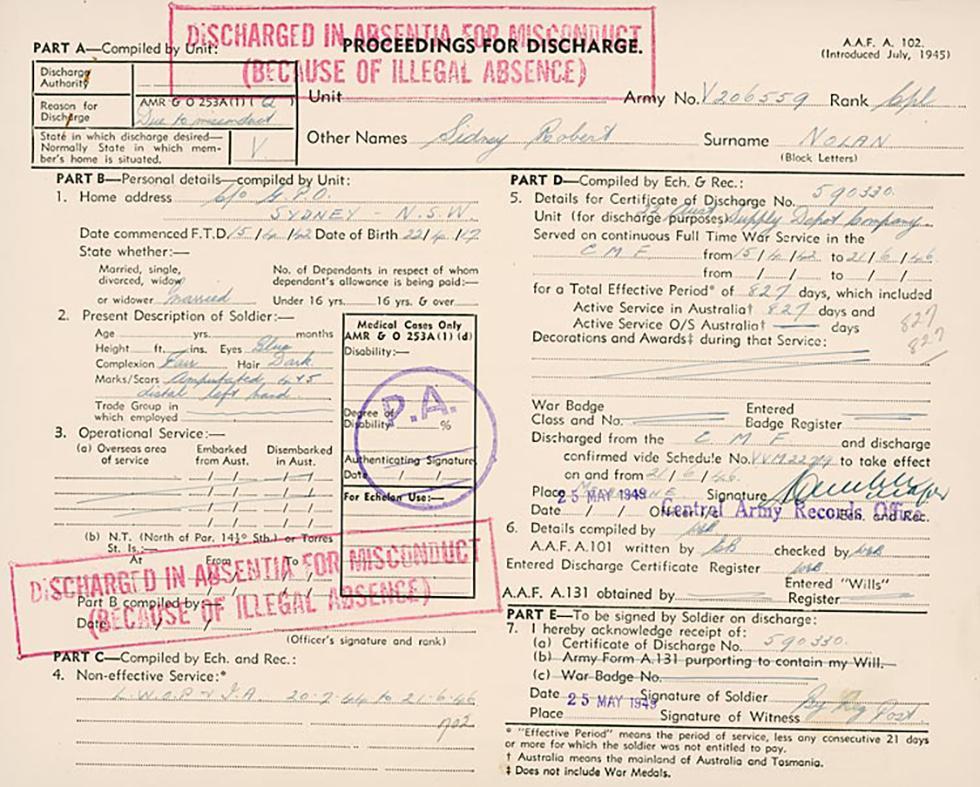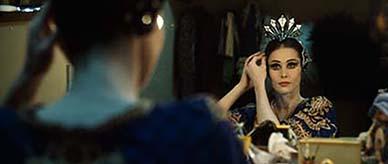


Transcript
[Stamp, in red ink reads:] DISCHARGED IN ABSENTIA FOR MISCONDUCT (BECAUSE OF ILLEGAL ABSENCE) [end stamp.]
PROCEEDINGS FOR DISCHARGE.
A.A.F. A. 102.
(Introduced July, 1945)
[Bold:] PART A – Compiled by Unit:
Discharge Authority[: blank.]
Reason for Discharge[:] AMR G O 253A (1) [handwritten:] (Q) Due to misconduct [end handwritten.]
State in which discharge desired – Normally State in which member's home is situated[:] [handwritten:] V [end handwritten.]
Unit[: blank.]
Army No. [handwritten:] V206559 [end handwritten.]
Rank [handwritten:] Cpl [corporal. End handwritten.]
Other Names [handwritten:] Sidney Robert [end handwritten.]
Surname (Block Letters) [handwritten:] NOLAN [end handwritten.]
[Dividing line.]
[Bold:] PART B – Personal details – compiled by Unit:
1. Home address [handwritten:] C/o [company of] G. P. O. Sydney – N.S.W. [end handwritten.]
Date commenced F.T.D. [handwritten:] 15/4/42 [end handwritten.]
Date of Birth [handwritten?] 22/4/17 [end handwritten.]
State whether: –
Married, single, divorced, widow or widower [handwritten:] married [end handwritten.]
No. of Dependents in respect of whom dependant's allowance is being paid: - Under 16 yrs. [blank] 16 yrs. & over [blank]
2. Present Description of Soldier –
Age [blank] yrs. [blank] months
Height [blank] ft. [blank] ins. Eyes [handwritten:] Blue [end handwritten.]
Complexion [handwritten:] Fair [end handwritten.] Hair [handwritten:] Dark [end handwritten.]
Marks/Scars [handwritten] Amputated 4 + 5 distal left hand [end handwritten.]
3. Operational Service: -
(a) Overseas area of service
Embarked from Aust.
Disembarked in Aust.
[four rows and three columns for data, all crossed out.]
(b) N.T. (North of Par. 14 ½° Sth) or Torres St. Is:-
At: [blank.]
From: [blank.]
To: [blank.]
[Box inserted containing the text:]
Medical Cases Only AMR & O 253A(1) (d)
Disability: - [blank.]
Degree of Disability [blank] %
Authenticating Signature
Date [blank.]
[Dividing line.]
For Echelon Use: - [blank.]
[end of box.]
[Circular stamp in purple ink, over box, reads:] P.A.
[Stamp, in red ink reads:] DISCHARGED IN ABSENTIA FOR MISCONDUCT (BECAUSE OF ILLEGAL ABSENCE) [end stamp.]
[Bold:] Part B compiled by: - [blank.]
Date: [blank.]
(officer's signature and rank) [bank.]
[Bold:] Part C – Compiled by Ech. (echelon) And Rec.:
4. Non-effective Service: * [handwritten:] L.W.O.P. & I. A. 20.2.44 t 21.6.46 902 [end handwritten.]
[Bold:] Part D – Compiled by Ech. & Rec. :
5. Details for Certificate of Discharge No. [handwritten:] 590330 [end handwritten.]
Unit (for discharge purposes) [handwritten:] 22 Aust. Supply Depot Company [end handwritten.]
Served on continuous Full Time War Service in the [handwritten:] C. M. F. [end handwritten] from [handwritten:] 15/4/42 [end handwritten] to [handwritten:] 21/6/46 [end handwritten.]
For a Total Effective Period * of [handwritten] 827 [end handwritten], which included
Active Service in Australia ꝉ [handwritten] 827 [end handwritten] days and
Active Service O/S Australia ꝉ [blank] days
[handwritten margin note reads '827 827'.]
Decorations and Awards ⱡ during that Service: [response area crossed out.]
War Badge Class and No. [response area crossed out.]
Entered Badge Register [response area crossed out.]
Discharged from the [handwritten] C. M. F. [end handwritten] and discharge confirmed vide Schedule No. [handwritten] VVM2219 [end handwritten] to take effect on and from [handwritten] 21/6/46 [end handwritten.]
Place [illegible.]
Signature [handwritten signature, illegible.]
Date [stamped] 25 MAY 1945 [end stamp]
Officer [stamped] Central Army Records Office [end stamp.]
Ech. And Rec.
6. Details compiled by [handwritten initials, illegible.]
A.A.F. A.101 written by [handwritten initials, illegible.] checked by [handwritten initials, illegible.]
Entered Discharge Certificate Register [handwritten initials, illegible.]
A.A.F. A.131 obtained by [response area crossed out.]
Entered "Wills" Register [response area crossed out.]
[Dividing line.]
[Bold:] Part E – To be signed by Soldier on discharge:
7. I hereby acknowledge receipt of:
(a) Certificate of Discharge No. [handwritten] 590330 [end handwritten.]
(b) [crossed out] Army Form A. 131 purporting to contain my Will.
(c) War Badge No. [end crossed out]
Date: [stamped] 25 May 1945 [end stamp.]
Signature of Solider [blank.]
Place [blank.]
Signature of Witness [handwritten] By My Post [end handwritten.]
[Dividing line.]
* "Effective Period" means the period of service, less any consecutive 21 days or more for which the soldier was not entitled to pay.
ꝉ Australia means mainland of Australia and Tasmania.
ⱡ Does Not Include War Medals.
About this record
This is the form completed on 25 May 1949 by the Australian Military Forces confirming that Corporal Sidney Robert Nolan, service number V206559, had been discharged in absentia from the Citizen Military Forces (CMF) for misconduct because of illegal absence. Nolan's service in the CMF was deemed to have ended on 21 June 1946, a total of 827 days from his enlistment, with the time from 20 July 1944 onwards classified as 'leave without pay' followed by illegal absence. The Army did not know Nolan's address and sent his discharge certificate via the General Post Office, Sydney.
Educational value
- This document records the end of a complicated period in the life of Sidney Nolan (1917–92), one of Australia's best known and critically acclaimed artists. Nolan had been conscripted into the army in 1942 during the Second World War (1939–45), commencing his service on 15 April. In August 1944 he deserted. Until 1948, he was in hiding, living and working under the assumed name Robin Murray, unable to resume his own identity and apprehensive that he would be caught.
- The discharge certificate gave Nolan the means to resume his identity and operate legally within the civilian world. He was initially discharged in absentia on 21 August 1946 for misconduct during service but no discharge certificate was prepared. In 1948 an amnesty for deserters was declared, enabling Nolan to come out of hiding. Despite his failure to report to the Melbourne depot with his army kit, Nolan's discharge was finally posted in 1949.
- Documents in his CMF personnel dossier imply that finding Corporal Nolan and returning him to duty were not high on the army's list of priorities. The army was already releasing men from duty in 1944 once it was clear that Australian troops would not be involved in the assault on the Philippines. The army was, however, quite concerned by the loss of Nolan's kit, which contained army-issue clothing and equipment valued at more than £15.
- While absent without leave and sometimes in hiding, Nolan painted prolifically. During this time he completed the iconic Ned Kelly paintings, many of which explore the themes of concealment and identity, concerns that were very close to Nolan's own experience while avoiding military authorities.
- An entry on this form reveals that Nolan had suffered the amputation of the ends of two fingers on his left hand during his army service. This had occurred in August 1943 and by November the army had recorded that no negligence or misconduct was involved. Injuries to the hand were usually considered suspicious as they were often self-inflicted by men trying to end their military service.
Acknowledgments
Learning resource text © Education Services Australia Limited and the National Archives of Australia 2010.
Related themes
Need help with your research?
Learn how to interpret primary sources, use our collection and more.


